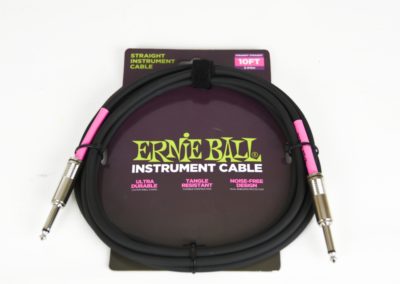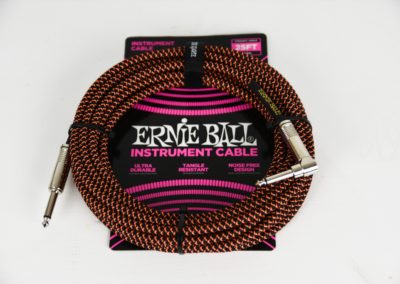Some time in September of this year, we are received our very first package from the MusicInfo company, which we and we are very appreciative of. In the consignment we found two Ashdown combos and three Ernie Ball instrument cables. The cables belong to the brand new collection, and the most recognizable thing about them are the two colors: bubble gum pink and lime. The new Ernie Ball cable look seems a little bit hipster-like but this doesn’t make them look bad. It’s all about your sense of style and we surely loved it. Let’s get started.
We’re testing Ernie Ball 6048, 6045 and 6064 cables
1. The product
What drew our attention after unpacking was exactly the look of the cables. The black one features an interesting pink outer sheath, the second one is white, with a tangled coil and a lime colour sheath, while the third one is probably the most characteristic because of its woven black and orange snake-skin-like coating. On the shields, you will find the Ernie Ball logo. The one that we took the greatest liking to was the glistening gold symbol featured on the orange and black cable.

photo: bassguitar.beatit.tv
2. Basic product specification
Manufacterer: Ernie Ball
Model: 6048
Wire: Dual-conductors with multiple shielding / two-core design with double anaerobic copper shielding
Connector 1: TS Male 1/4
Connector 2: TS Male 1/4
Cable colour: Black with a pink shield
Cable length: 3.04 m
Manufacterer: Ernie Ball
Model: 6045
Wire: Dual-conductors with multiple shielding / two-core design with double anaerobic copper shielding
Connector 1: TS Male 1/4
Connector 2: TS Male Right Angle 1/4
Cable colour: White with a lime shield
Cable length: 9 m
Manufacterer: Ernie Ball
Model: 6064
Wire: Dual-conductors with multiple shielding / two-core design with double anaerobic copper shielding
Connector 1: TS Male 1/4
Connector 2: TS Male Right Angle 1/4
Cable colour: White wth a lime shield
Cable length: 7.62 m
3. Test
The cables were tested in the order of the specifications above. Let us take a closer look at product performance. The manufacturer’s description features denotations such as “instrument cable” and “professional” alongside the name and, in this particular case, you can absolutely rely on this description. The cables look pretty solid and, indeed, they are. Both aesthetes and practitioners should be pleased.
The company description of the cables reads: Ernie Ball instrument cables feature a high-quality design made with superior components that are built to last. Dual-conductors deliver reliably clear tone with crisp highs, tight mids, and rich harmonics. Multiple shielding materials preserve the signal with low handling noise, and the braided jacket exterior provides a tangle-resistant experience.
The fact is we couldn’t hear any noises and each of the cables tested sounded little bit different from the other. The black one, when compared with the other two, sounds the most “shallow”, somewhat lacking a bit in the highest and lowest end. Nevertheless, it’s a very solid cable. The black and orange one has a little bit more bass than the black one, but the differences are not very significant. The coiled white one is probably our favorite (if we had to pick a winner, that is). In comparison to the rest of the cables, the 6064 sounds a bit as if a tube amplifier was built in, i. e. it has that warm quality of an old vinyl record with warm and nice low frequencies.
4. Summary
If you are looking for a professional, nicely done and good-sounding cable that your eyes will enjoy, we can certainly recommended these three. They shouldn’t cause you any problems. The price-to-quality ratio is 5/5, we think. We advise you to get acquainted with Ernie Ball’s offer, especially the 6064. They come in several color options and they present themselves very nicely.
Manufacturer: https://www.ernieball.com/guitar-accessories/instrument-cables/
OUR VERDICT: 5/5
Advantages:
- Great finish
- Eye-catching look
- Warm and soft low frequency
- Very good price-to-quality ratio
Disadvantages:
- None









